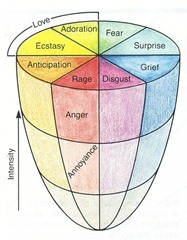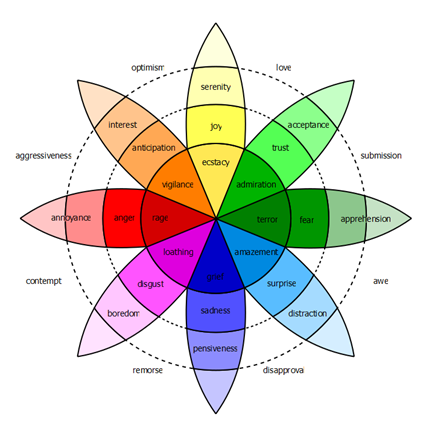Last week, I was counting basic plots and getting nowhere with the numbers game – I think if you follow all of the references in the article, you get to 18 or 54 or something in between. I didn’t try to put a number on it.
But have you noticed how many of us like to enumerate and collect? Mostly it’s men, I hear some of you say, but I am not so sure. Anyway, Howard Gardner noticed this, belatedly, when he added to his original seven Multiple Intelligences an eighth: Naturalist.
Seven …
there’s another magic number to add to last week’s three:
- Seven samurai
- Seven pillars of wisdom
- Seven deadly sins
- Seven wonders of the world
- Seven against Thebes
- Seven dwarves
- Seven habits of highly effective people
One characteristic of the naturalist intelligence is the desire and facility to characterise, categorise and count (ooops three again!).
Let’s get Emotional
This time, I have been wondering how many emotions there are. Two things may come to your mind: the pragmatists will say ‘but what has this to do with management?’ while the theorists will challenge ‘can you really count emotions?’
Let’s start with the theorists: counting emotions
No. I don’t think that you can create a full count of the infinite varieties of human emotion, but I did think it may be interesting to try to list the main ones, and see where it takes me.
I started with a throwaway comment I remembered from a training course that there is a ‘big five’ set of emotions. I can find no reference to these (unlike the ‘big five personality factors’ in any psychology books). But I did find a Reiki Healing site, and as my NLP teachers were also reiki practitioners, I’m going to make a guess…
Anyway, this led me to:
- Joy
- Sadness
- Anger
- Fear
- Grief
… which are big and there are five. But there are other big ones too. Next stop: Claudia Hammond’s excellent ‘Emotional Rollercoaster: A Journey Through the Science of Feelings’. Dr Hammond lists
- Joy
- Sadness
- Disgust
- Anger
- Fear
- Jealousy
- Love
- Guilt
- Hope
She doesn’t set out to be comprehensive, just to present fascinating research results. The web will offer you uncountable numbers of lists, but in my £2.99 copy of the textbook ‘Psychology’ (I love charity shops), I found Plutchik’s Multi-dimensional Model of Emotions. Oh how I love the idea of a multidimensional model!
 As you can see, Plutchik’s model has eight primary emotions which are shown next to the ones they are most like and opposite the ones that are like polar opposites. Each has a spectrum of intensity, giving a third dimension, with the peak intensity emotions at the top. By combining adjacent pairs, you get more complex emotions.
As you can see, Plutchik’s model has eight primary emotions which are shown next to the ones they are most like and opposite the ones that are like polar opposites. Each has a spectrum of intensity, giving a third dimension, with the peak intensity emotions at the top. By combining adjacent pairs, you get more complex emotions.
To see this more clearly, we need to open out the solid, and this is done in many places on the web. Here is my favourite representation (a public domain image from Wikipedia).
.
You’ll notice that the two versions don’t quite match up (- as my editor did!*). The opened out “net” seems the more current and common articulation, with the levels on the “solid” diagram either poorly represented or from earlier thinking.
What has this to do with management?
Well, firstly, if you think that emotions and management have nothing to do with one another, you’re crazy. But my serious point is that a greater understanding of emotions seems to me to be a major gap in much management training and education. This is even true in many workshops and courses about ‘Emotional Intelligence’.
Yet Emotional Intelligence is one of the most powerful management models of the last twenty years. I think we can now tentatively apply the label ‘enduring’. So we’ll be taking a deeper look over the next two weeks.
___________
* In trying to answer my editor’s comment, I found two absolutely fascinating articles on the web (30 minutes of displacement activity – thank you Ros) that you might like. Plutchik’s original 1960 article is not available on the web (unless you have £23 to spare). Anyway, check out:

